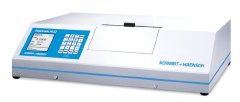Jun 6 2009
The new POLARTRONIC H532 automatic polarimeter features a high accuracy of ±0.002° and comes with 5 optical wavelengths. The H532's measurement speed, 4th decimal resolution, and accuracy are unmatched among polarimeters in the industry. "This is one special instrument," remarks Marketing Manager, Paul Wendling. "Our competitors that can even approach the S+H H532 with respect to accuracy can only achieve it within the range of ±1°. The H532 achieves the same level of accuracy across the full measurement range of ±89°. That's truly phenomenal."
 Automatic Polarimeter H532 offers ±0.002° accuracy across the entire measuring range.
Automatic Polarimeter H532 offers ±0.002° accuracy across the entire measuring range.
Polarimeters determine the optical activity of a solution by means of a rotating analyzer and an optical encoder. Schmidt+Haensch POLARTRONIC automatic polarimeters make use of a (S+H patented) direct, electronic interface between the analyzer and the optical encoder. This technique allows for exceptional speed in measurements and consistent accuracy across the entire measuring range. All other polarimeter manufacturers employ mechanical linking of the analyzer and optical encoder. This results in much slower measuring time, inconsistent accuracy across the measurement range, and shortened service life due to mechanical wear and tear.
The H532 automatic polarimeter has optical wavelengths at 365nm, 435nm, 546nm, 578nm, and 589nm. Additional custom wavelengths are available on request. The H532 polarimeter comes standard with mercury and sodium light sources, a menu-driven backlit LCD display, password protection, and printer, serial, and USB ports.
A wide selection of samples cells and quartz control plates are also available.
Potential applications of the new S+H H532 automatic polarimeter include:
- Quality control of original, intermediate, and final products
- Purity control and substance concentration determination conforming to U.S. & European Pharmacopoeia standards
- Analysis of sugar and albumin in urine
- Hormone, enzymology, and toxicology research
- Purity control and identity of essential oils
- Purity control and determination of organic fluids and inorganic ions
- Analysis of optically active compounds
- Determination of configuration changes of macromolecules in solutions